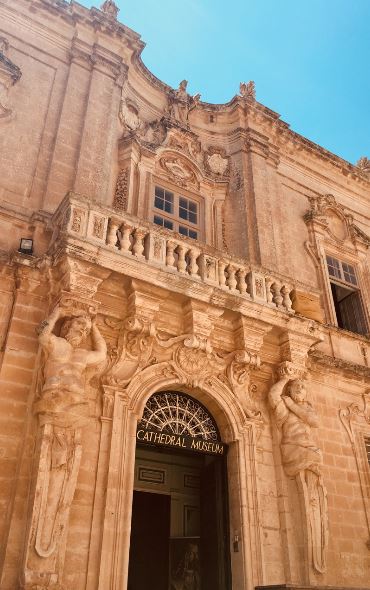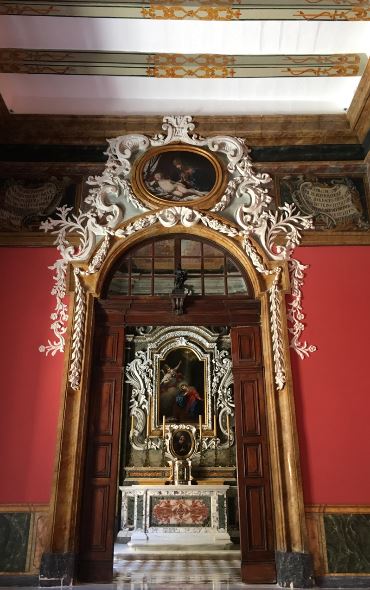From the opulence of its facade to the magnificent religious (and non) artefacts within, this underrated museum in the former capital is a must see.
Malta’s baroque palazzos all boast some very elaborate stonework on their facades, but few can beat the bombastic opulence of the Cathedral Museum in Mdina. And while religious iconography might not be your cup of tea, this one is well worth a visit as a testament to Malta’s rich religious heritage, which is inevitably and inexorably intertwined with our cultural history.

Adriana Bishop
Located to the right of the Metropolitan Cathedral in Mdina, the museum was originally constructed in 1733 to be used as a seminary. It was most likely designed by Andrea Belli and was inaugurated nine years later. At the time, there were 1,679 priests in Malta (which was roughly two per cent of the population).
In keeping with the style of baroque palaces of the era, it was built surrounding a central courtyard directing fresh air and sunlight to all the rooms and halls all year round. The seminary featured classrooms, dormitories, a chapel, an assembly hall, a large kitchen and refectory as well as stores. It served as a seminary until 1858 and would continue to be used for myriad purposes including as the British military headquarters during the Crimean War. The British added fireplaces, as was their wont in Victorian times. During World War II, St Edwards College relocated from the heavily bombed Cottonera area and took up temporary residence in the former seminary in the relative safety of Mdina.
The Cathedral Museum itself was established in 1897 when Count Saverio Marchesi bequeathed his priceless collection of engravings by Albrecht Durer to the cathedral with the express wish of having them exhibited in a museum. The Durer engravings are one of the main highlights of the museum, which officially opened its doors to the public in 1969 . Durer’s ambitious woodcuts revolutionised the medium, and he was considered to be one of the most important figures of the Northern Renaissance. The collection of engravings at the Mdina musuem is one of the largest outside Germany, and includes the complete set of the Life of the Virgin on woodcuts, as well as the whole collection of The Small Passion on copper plates.

Adriana Bishop
One of the most fascinating exhibits is Petronilla, a bell cast in 1370 by the Venetian bell founders Victor and Nicolaus. The medieval bell in its 'sugarloaf' shape is one of the rarest large extant examples in the campanological world. It also happens to be the oldest bell in Malta. The bell was named Petronilla in honour of St Peter when it was consecrated in 1645. This bell is one of the few items to survive after the devastating earthquake of 1693 destroyed the original cathedral of Mdina. The bell remained in service in the cathedral’s belfry until as recently as 2008, when it was finally lowered and exhibited in the museum. However, you can still hear a digital recording of Petronilla’s particular medieval tone.
The strong devotion to the Catholic church in Malta inevitably led to some very generous contributions leaving a rich legacy of ornate silverware. Moreover, former Speaker of Parliament Dr Jimmy Farrugia bequeathed his extensive collection of rare Maltese silver as well as other objets d’art to the museum. The late Dr Farrugia was an expert in Maltese silverware, and his collection dates back to the 17th century and includes a cruet set used by Grandmaster de Vilhena.

Adriana Bishop
The first exhibit to greet you as you start your tour is the sparkling group of 15 silver statues dating back to 1741 depicting the apostles, John the Baptist, St Paul and Our Lady. The statues, which were made by Roman silversmith Antonio Arrighi, have quite a history, and a ransom of sorts had to be paid twice to the French during the Blockade of 1798-1800 to stop them from being minted for coins to pay the French troops.
One of the rooms is also dedicated to national poet Dun Karm Psaila, who penned the lyrics to the National Anthem. Dun Karm used to lecture in Mdina during 1919. The room includes his piano and several of his handwritten notes and poems. Finally, don’t miss the chapel on the first floor, a mini-museum in its own right with its fake dome and paintings by Antoine Favray, the most prolific court painter in Malta during the Baroque period.
The Mdina Metropolitan Museum is open from Monday to Saturday from 9:30am to 5pm. The €5 ticket includes entry into the Cathedral and a very small exhibition at Palazzo de Piro.